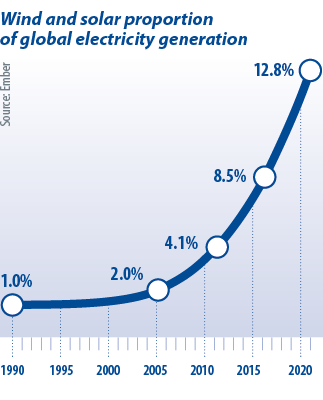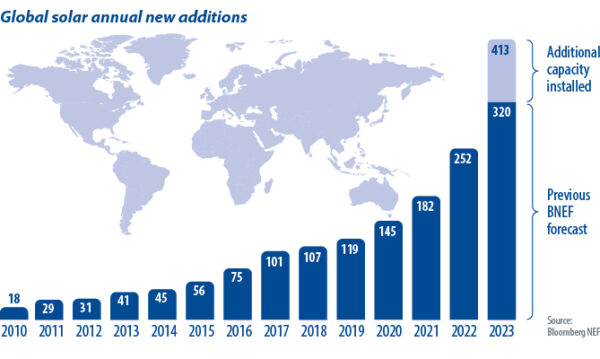Energy is the cornerstone of progress. Our quality of life is inextricably linked with access to, and utilization of, external energy sources. Electricity is the most versatile and practical form of energy available to us. We can endure prolonged periods without coal, gas, or oil but electricity is indispensable as it underpins the functionality of modern life. Imagine a major city suddenly deprived of electricity. There would be chaos. Fortunately, across much of the world, we have established robust electricity systems that provide us with reliable and cost-effective power 24/7.
 We are swiftly transitioning to cleaner sources of electricity, leaving behind the era of dirty coal and other fossil fuels. Solar and wind generated more than 14% of global electricity in 2023 (see chart right), marking a nearly fourfold increase over a decade. In the same period, an astonishing 413 GW of solar generation capacity was deployed globally. Global wind installations also reached record levels in 2023, approaching 105 GW.
We are swiftly transitioning to cleaner sources of electricity, leaving behind the era of dirty coal and other fossil fuels. Solar and wind generated more than 14% of global electricity in 2023 (see chart right), marking a nearly fourfold increase over a decade. In the same period, an astonishing 413 GW of solar generation capacity was deployed globally. Global wind installations also reached record levels in 2023, approaching 105 GW.
The path forward involves a significant electrification of our societies, as outlined by the International Energy Agency (IEA) in its roadmap to net-zero emissions by 2050 (see chart below). The focus is on replacing fossil fuels with clean electricity and implementing energy-efficiency measures. The synergy between the two is promising. For example, electric cars and heat pumps offer much greater efficiency than internal combustion engines or gas stoves. This increased efficiency translates to reduced energy losses, lower fuel costs, and decreased CO2 emissions. When we factor in efficiency measures across industry, buildings, appliances, and transport, it becomes evident that the IEA’s net-zero scenario is attainable. What the IEA does not fully anticipate is the impending renewable-era revolution, spearheaded by solar energy.

Huge potential
Globally, the Earth’s surface receives approximately 170 W of sunlight energy per square meter, on average, with high-pressure zones around the tropics receiving more than 250 W per square meter. Given modern solar technology, and assuming 20% conversion efficiency, we could meet global energy needs with an area the size of the Sahara Desert if we effectively harnessed this energy.
Solar power seems to be the perfect solution for the world, from a theoretical standpoint. It offers free, boundless, clean energy. Solar energy fuels bioenergy, it serves as the primary source for wind energy, hydro energy, and was even the ultimate source of energy for the fossil fuels that developed over millions of years.
We have the ability to convert solar energy into its most usable form – electricity – at a low cost. Photovoltaics have the advantage of applicability in both small- and large-scale installations. PV can be integrated into roofs and facades or deployed in large-scale plants with ease. Installation is straightforward and requires minimal or no maintenance.
These factors explain why, in 2023, there were more solar installations worldwide than all other forms of power generation combined. To put that into perspective, the scale of solar installation in 2023 exceeded the cumulative global nuclear fleet, which has been built up over five decades. Solar is setting unprecedented records and even experts continually underestimate its installation rates. A year ago, analysts at BloombergNEF projected 320 GW of solar installations for 2023, a number that will likely have been exceeded (see chart below).

In 2024, the global solar market is poised to reach 500 GW of annual installations. Over the past five years, we will have installed as much solar capacity as the world’s coal power generation fleet. This signifies a revolution, albeit one marked by intermittent energy production, as some critics contend.
Neural grid
The solution to this intermittency challenge is the “neural grid,” a term coined by analyst Guidehouse Insights some years ago. In the neural grid, data and intelligence are predominantly housed in the cloud. The grid makes use of widespread connectivity, artificial intelligence, and the growing number of devices connected to the internet. It manages the interface of generation assets and distribution networks with energy consumers, buildings, transportation infrastructure, city systems, and assets such as solar, wind, and energy storage systems.
Essentially, the “neural grid” empowers the world’s largest machine, the power grid, with intelligence. This presents a substantial growth opportunity that will unlock significant consumer value, drive decarbonization, and reshape societies.
Role of storage
Energy storage is also pivotal. Over the past century, we have built extensive energy storage capability. For instance, the United States has strategic reserves of crude oil sufficient to meet national needs for more than a month. There is also substantial storage capacity for coal and natural gas. The same cannot be said for electricity. Unlike other energy forms, electricity must be utilized immediately or converted into another form before re-use. Common methods include the use of spinning turbine masses (inertia), pumped hydro, and batteries. The world lacks enough backup energy storage capacity to sustain even a single day without electricity. Consequently, our power systems rely on fossil fuel storage as backup. The battery revolution is the next critical component of the renewables-era transition.
Batteries are a vital, albeit often overlooked, part of our lives. Our digital existence depends on batteries, which provide the portable power required for our electronic devices. The sheer number of batteries in our surroundings is staggering (see chart below). I identified more than 300 batteries in my home, ranging from button-sized devices in my watch to a 120 kg battery used for home storage.

The demand for high-performance batteries, such as lithium-ion devices, has surged at an unprecedented rate. In 2013, the high-performance battery market amounted to 45 GWh of energy storage capacity, primarily serving mobile devices and laptops. Last year, this market expanded to nearly 1.1 TWh, a 24-fold increase. Meanwhile, battery pack prices have plummeted by 80% and, all the while, battery performance continues to improve. Most of those batteries are being deployed to electrify cars and other vehicles. Batteries are already a foundational element of the renewables-era revolution, and their significance will only amplify, going forward.
Batteries play a pivotal role in the electrification of transportation, where we have already reached a tipping point in terms of ownership costs. Future innovations and economies of scale will further drive down expense to achieve price parity between internal combustion engines and electric vehicles, based on sticker prices. Those electric vehicles will serve as grid resources, charging when renewable energy is abundant and discharging when it is scarce.
Continued enhancements in performance, and cost reductions, will open up new markets, starting with off-grid solutions and expanding to residential homes and buildings. A prime example can be found in Germany, where almost 70% of residential solar owners installed storage systems to complement their panels last year. That choice is driven by the economic advantage of utilizing excess self-generated power for internal consumption, instead of exporting it to the grid.
We will also witness a proliferation of large-scale stationary storage sites, to ensure 24/7 power reliability for grid operators. These storage facilities will mitigate price volatility in wholesale energy markets and enable the expansion of cost-effective intermittent renewables.
Expect significant innovations, particularly in longer-duration storage solutions, where lithium-ion may not be the ultimate choice. Technology such as sodium-ion batteries could gain prominence. Ultimately, low-cost storage for the electricity grid will become ubiquitous.
Pump action
The final crucial technology in the renewables era is the heat pump. These devices boast high efficiency, delivering three to five units of heat for each unit of electricity consumed, thanks to their ability to harvest “free energy” from the difference between inside and outside temperatures. Heat pumps are already the primary method of heating homes in Nordic countries such as Norway. Many heat pumps can also be configured for cooling purposes. While heat pumps themselves are not new, innovations surrounding refrigerants – the fluids that circulate and transfer heat – are advancing. Innovations are also taking place in thermal storage and the control and management of heat pumps, opening new markets and stimulating growth opportunities. Mass-production capacities are scaling up worldwide, further driving down costs. Heat pumps are poised to become a versatile solution for heating and cooling buildings efficiently and affordably.
History repeats
Energy revolutions occur periodically. The last major incidence was the oil boom at the beginning of the 20th century. In 1900, daily oil extraction stood at 150,000 barrels, today it exceeds 100 million barrels. The resultant wealth has been instrumental in the prosperity of the United States, Saudi Arabia, and many other nations.
Presently, we find ourselves in the midst of another energy revolution: the renewables-era revolution. It represents both a significant opportunity and a challenge for companies and countries worldwide. Four pivotal technologies – solar, batteries, digital connectivity, and heat pumps – will facilitate global decarbonization. They will usher in wealth for those who embrace them.
 About the author: Gerard Reid is a co-founder and partner of Alexa Capital. He has spent more than 20 years focusing on investment banking, equity research, fund management, and corporate finance, with a focus on the energy transition and the digital energy revolution. He was previously managing director and head of European cleantech research at Jeffries & Co.
About the author: Gerard Reid is a co-founder and partner of Alexa Capital. He has spent more than 20 years focusing on investment banking, equity research, fund management, and corporate finance, with a focus on the energy transition and the digital energy revolution. He was previously managing director and head of European cleantech research at Jeffries & Co.
The views and opinions expressed in this article are the author’s own, and do not necessarily reflect those held by pv magazine.
This content is protected by copyright and may not be reused. If you want to cooperate with us and would like to reuse some of our content, please contact: editors@pv-magazine.com.








By submitting this form you agree to pv magazine using your data for the purposes of publishing your comment.
Your personal data will only be disclosed or otherwise transmitted to third parties for the purposes of spam filtering or if this is necessary for technical maintenance of the website. Any other transfer to third parties will not take place unless this is justified on the basis of applicable data protection regulations or if pv magazine is legally obliged to do so.
You may revoke this consent at any time with effect for the future, in which case your personal data will be deleted immediately. Otherwise, your data will be deleted if pv magazine has processed your request or the purpose of data storage is fulfilled.
Further information on data privacy can be found in our Data Protection Policy.